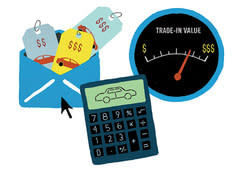10 easy steps to the best car deal


Driving off a dealer’s lot in a shiny new car can be exhilarating, but the hours you might spend haggling to get to that point can be about as pleasant as a tax audit. Buyers tell us they often feel manipulated by sales staff. Or they worry that they paid too much for their vehicle, got too little for their trade-in, or were pressured into buying features they didn’t need.
Here at Consumer Reports, we buy all the cars we test (about 80 a year), so we know how stressful it can be, and we’ve learned effective tricks and strategies. Below is our step-by-step car-buying process based on the experiences we’ve had in hundreds of dealerships. And best of all, much of it can be done from your home.
[More from Consumer Reports: Best & worst new cars]
Start online. Before you head out to dealerships, go to automaker websites. There you can check out prices, trim lines, and options. The sites will spell out the name and content of each option package and provide suggested retail prices. Most let you "build" the car you want and provide access to the inventories of dealerships near you. But be aware that the car you build might not always be available. While you’re at the computer, also go to the websites of dealerships in your area. Dealer sites might list the actual cars on hand and advertise any consumer incentives. You can also get a rundown of any cash rebates and behind-the-scenes dealer incentives at car-pricing websites and through Consumer Reports’ New Car Price Reports, which cost $14. They also show current transaction prices.
Take test drives. Go to dealerships and drive any vehicle you’re considering with the options and powertrain you plan to get. Spend about a half-hour in each car and drive it in a variety of road conditions. Pay attention to such things as seat comfort and passenger space. But don’t let the sales staff pressure you into negotiating at this stage.
Get approved for financing early. Shop online for financing or contact local banks, credit unions, and other financial institutions to see what interest rates they are offering on auto loans. Then see how the dealership’s financing compares. Taking care of this in advance and getting pre-approved for a loan takes a lot of stress out of the negotiating phase.
Find your old car’s trade-in value.Get the book value by using online car-pricing services such as Edmunds and Kelley Blue Book. Focus on the wholesale value; factor in mileage and features.
Get price quotes. You can do that from home by sending e-mail requests or calling several dealers in your area. Tell them the exact model, trim level, and options you want and ask for their lowest price. You can also get quotes online at such sites as AutoTrader, CarsDirect, and Cars.com. Subscribers to Consumer Reports can use our Build & Buy service to get guaranteed quotes from local dealers who meet a high level of customer satisfaction. It’s free to use, you aren’t obligated to buy, and you remain anonymous until you choose a dealer to work with.
Have dealers compete. You can often whittle the price down by contacting dealers and asking whether they can beat a competitor’s price. That can be useful if you prefer a particular dealer because of location or good rapport but another one gave you a lower price. Once you settle on a dealer, you’ll have to go in to close the deal.
Negotiate everything separately. Once you’re in the showroom, a salesman will probably want you to focus on how much you can afford in monthly payments. Don’t go down that road. Lumping together the new-car price, trade-in, and financing (if needed) allows a dealership to give you a good price in one area while making up for it in another.
Skip the add-ons. Extra-cost items like VIN etching on the window glass, paint sealant, fabric protection, wheel-nut locks, and extended service warranties are a waste of money. If those items are printed on your purchase order, cross them out before you sign and make sure the dealership adjusts the price.
Check the math. Take a calculator to the dealership to verify that the terms match the amount you’ve agreed to finance. Dealerships can pad the monthly payment to add extras into the contract, sometimes without you realizing you’re paying for them.
Finalize the paperwork. Don’t sign any forms with lines left blank and don’t drive any car home until the financial terms have been approved by the lender. Some dealerships have been known to call back customers, saying that the financing fell through, just to get them to sign new—and less favorable—financing terms.
[More from Consumer Reports: Top electronic products]
Consumer Reports has no relationship with any advertisers on Yahoo!
Copyright © 2009-2013 Consumers Union of U.S., Inc. No reproduction in whole or in part without written permission.
More From Consumer Reports

